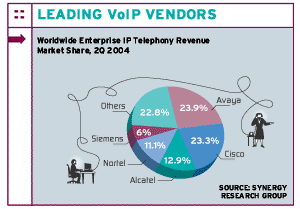|
|
DSC Tech Library
Computer Telephony Integration
 This section of our technical library presents information and documentation relating to CTI Computer Telephony Integration software and products.
Computer Telephony Integration CTI software is a rich set of phone software library routines that enable application programs to control your phone system.
This comprehensive CTI software lets you increase employee productivity, enhance customer service and reduce costs by combining the capabilities of our PACER phone system with the custom functionality of your Windows, Unix or Web applications.
Data collected by your phone ACD (Automatic Call Distribution) or IVR (Interactive Voice Response) systems can be passed to your existing PC, Unix or Web applications through our phone software.
The PACER predictive dialer can automatically call your customers and pass only connected calls to your agents. With our computer telephony software, your telephone and computer work together to provide cost-saving benefits.
This section of our technical library presents information and documentation relating to CTI Computer Telephony Integration software and products.
Computer Telephony Integration CTI software is a rich set of phone software library routines that enable application programs to control your phone system.
This comprehensive CTI software lets you increase employee productivity, enhance customer service and reduce costs by combining the capabilities of our PACER phone system with the custom functionality of your Windows, Unix or Web applications.
Data collected by your phone ACD (Automatic Call Distribution) or IVR (Interactive Voice Response) systems can be passed to your existing PC, Unix or Web applications through our phone software.
The PACER predictive dialer can automatically call your customers and pass only connected calls to your agents. With our computer telephony software, your telephone and computer work together to provide cost-saving benefits.
VoIP Isn't Hype Any Longer
Citing rising customer comfort, VARs report solid growth through first-half 2004
By Jennifer Hagendorf Follett, CRN
VoIP continues to enjoy stellar growth and is one of the few bright spots on the IT landscape, solution providers say.
A report recently issued by Synergy Research Group concurs that VoIP sales are on the rise. According to the report, the worldwide enterprise IP telephony market grew about 75 percent in the second quarter of this year to $728 million, up from $414.7 million during the same quarter last year.
Through the first half of 2004, enterprise IP telephony sales grew 71 percent to $1.36 billion, up from $796.8 million in the first half of 2003, according to the report.
"VoIP is the only sexy thing out there right now," said Jim Gildea, president of Aegis Associates, a solution provider in Watertown, Mass. Aegis' VoIP sales are built primarily around technology from Cisco Systems and have doubled over the last year, Gildea said.
IP telephony sales are up for solution provider Xitech as well, in part because customers are becoming more comfortable with the technology, said Jim Sommer, president of the Carnegie, Pa., company.
"The technology has settled down, and we can bring our customers to many [reference] sites now in multiple industries," Sommer said. "There are customer success stories out there, so people are not afraid of it," he said.
Xitech is bulking up its IP telephony practice through new hires and by retraining existing personnel to get them up to speed on VoIP, Sommer said.
ROI Networks, an 18-month-old solution provider in San Juan Capistrano, Calif., has grown its convergence sales and service revenue by 500 percent year over year, said Jeff Hiebert, CEO of the Avaya partner.
One of the primary drivers of VoIP is server consolidation, or the ability for businesses to deploy and manage IP telephony systems and applications centrally using survivable gateways in remote locations, Hiebert said. This enables branch offices to enjoy the same features and functionality as users at headquarter locations, unlike traditional telephony deployments where each branch's system has limited functionality.
"It takes the cost and complexity out of branch office deployments," Hiebert said.
ROI Networks' VoIP business is also climbing because of promotions from Avaya that encourage the solution provider's legacy customer base to upgrade to IP telephony, he said.
 Avaya and Cisco continue to duel for the top spot in the IP telephony market, with Avaya maintaining a slim lead in revenue market share in the second quarter, according to Synergy. For the quarter, Avaya held 23.9 percent of the market, while Cisco staked out a 23.3 percent share, according to the research report. For Avaya, that represented an increase in share, up from 20.3 percent in the second quarter of 2003. Cisco lost share, down from its 25.8 percent stake a year ago, according to the report.
Avaya and Cisco continue to duel for the top spot in the IP telephony market, with Avaya maintaining a slim lead in revenue market share in the second quarter, according to Synergy. For the quarter, Avaya held 23.9 percent of the market, while Cisco staked out a 23.3 percent share, according to the research report. For Avaya, that represented an increase in share, up from 20.3 percent in the second quarter of 2003. Cisco lost share, down from its 25.8 percent stake a year ago, according to the report.
The top five vendors in terms of market share for the second quarter also included Alcatel, with 12.9 percent of the market, Nortel Networks, with 11.1 percent and Siemens, with a 6 percent share.
The market for IP phones in the second quarter grew 84 percent compared with the same quarter a year ago, according to the report. Cisco was the dominant market leader for IP phones with a 38.9 percent share. Avaya followed with 13.6 percent. Other vendors in the top five included Nortel, with 10.5 percent of the market, Alcatel, with 9.9 percent and Mitel Networks, with a 7.4 percent share.
Other drivers of VoIP sales include cost savings, productivity gains and mobility features, solution providers say.
"It's all about IP today. No one calls and asks us about anything but IP," said John Graven, COO of Computer Telephony Concepts, a solution provider in Cleveland that works with vendors such as 3Com and AltiGen Communications. Graven noted that requests for IP telephony are up 75 percent over the last year. "It's mainstream," he added.
|


 This section of our technical library presents information and documentation relating to CTI Computer Telephony Integration software and products.
Computer Telephony Integration CTI software is a rich set of phone software library routines that enable application programs to control your phone system.
This comprehensive CTI software lets you increase employee productivity, enhance customer service and reduce costs by combining the capabilities of our PACER phone system with the custom functionality of your Windows, Unix or Web applications.
Data collected by your phone ACD (Automatic Call Distribution) or IVR (Interactive Voice Response) systems can be passed to your existing PC, Unix or Web applications through our phone software.
The PACER predictive dialer can automatically call your customers and pass only connected calls to your agents. With our computer telephony software, your telephone and computer work together to provide cost-saving benefits.
This section of our technical library presents information and documentation relating to CTI Computer Telephony Integration software and products.
Computer Telephony Integration CTI software is a rich set of phone software library routines that enable application programs to control your phone system.
This comprehensive CTI software lets you increase employee productivity, enhance customer service and reduce costs by combining the capabilities of our PACER phone system with the custom functionality of your Windows, Unix or Web applications.
Data collected by your phone ACD (Automatic Call Distribution) or IVR (Interactive Voice Response) systems can be passed to your existing PC, Unix or Web applications through our phone software.
The PACER predictive dialer can automatically call your customers and pass only connected calls to your agents. With our computer telephony software, your telephone and computer work together to provide cost-saving benefits.
 Avaya and Cisco continue to duel for the top spot in the IP telephony market, with Avaya maintaining a slim lead in revenue market share in the second quarter, according to Synergy. For the quarter, Avaya held 23.9 percent of the market, while Cisco staked out a 23.3 percent share, according to the research report. For Avaya, that represented an increase in share, up from 20.3 percent in the second quarter of 2003. Cisco lost share, down from its 25.8 percent stake a year ago, according to the report.
Avaya and Cisco continue to duel for the top spot in the IP telephony market, with Avaya maintaining a slim lead in revenue market share in the second quarter, according to Synergy. For the quarter, Avaya held 23.9 percent of the market, while Cisco staked out a 23.3 percent share, according to the research report. For Avaya, that represented an increase in share, up from 20.3 percent in the second quarter of 2003. Cisco lost share, down from its 25.8 percent stake a year ago, according to the report.